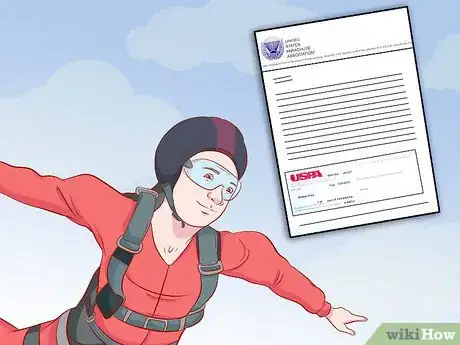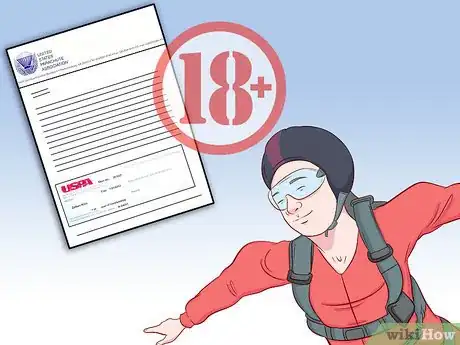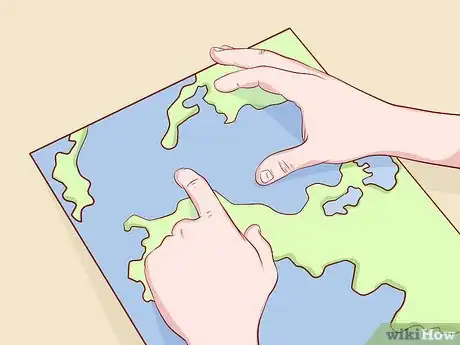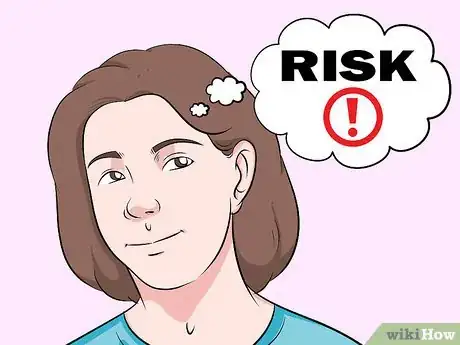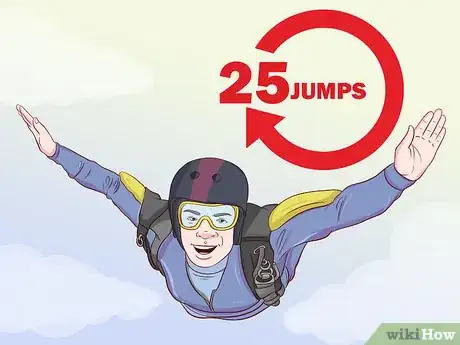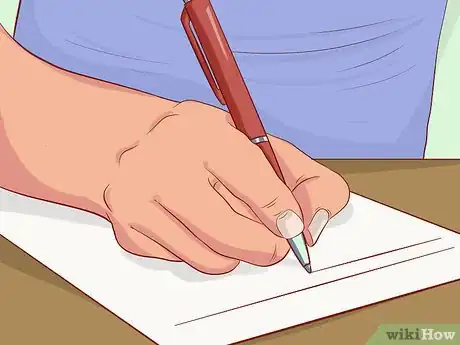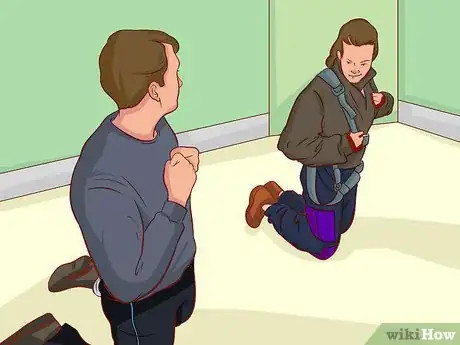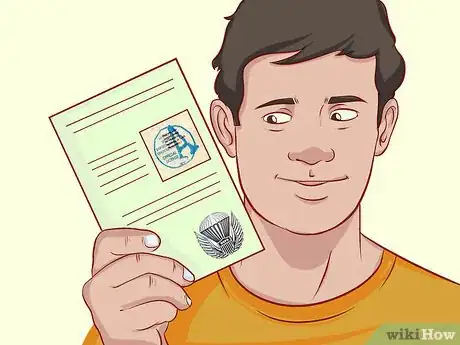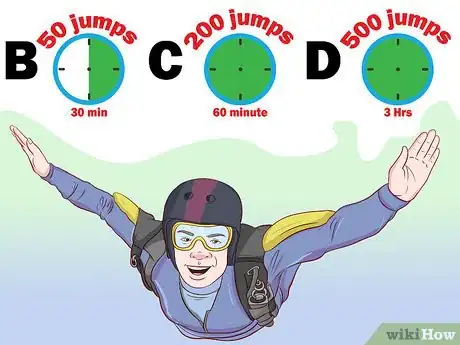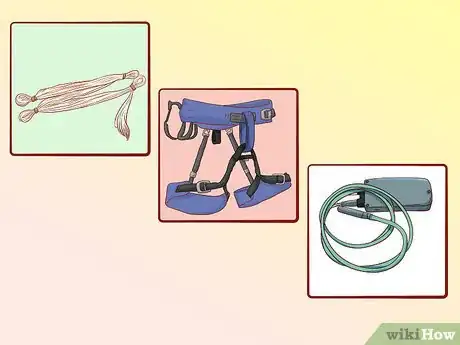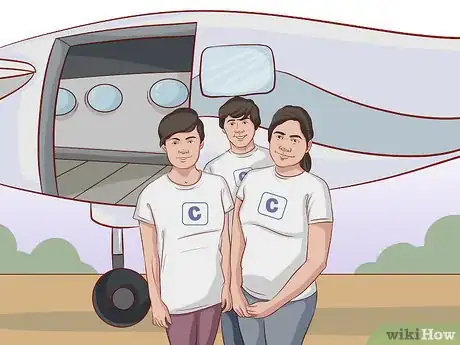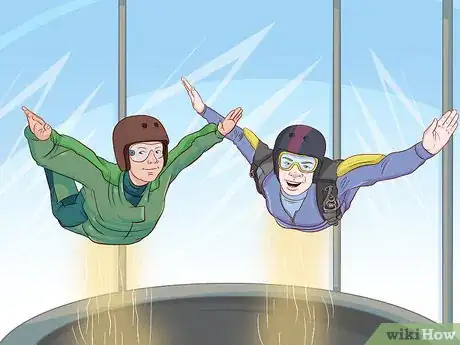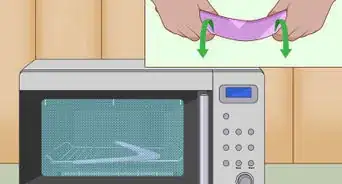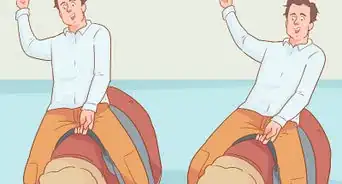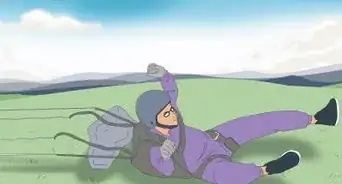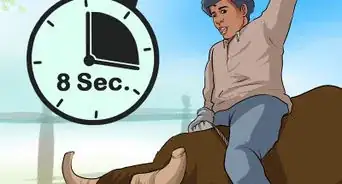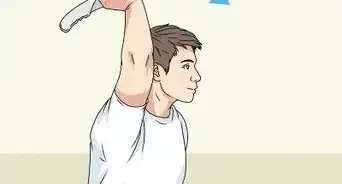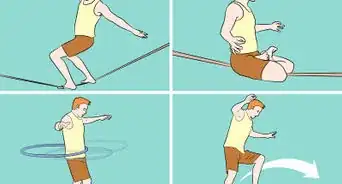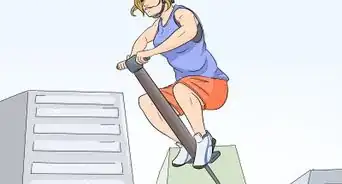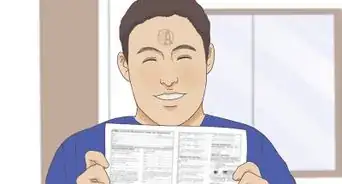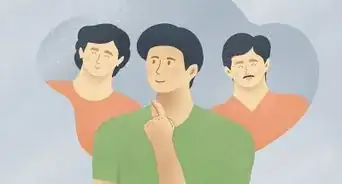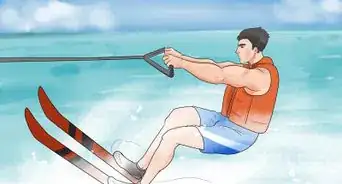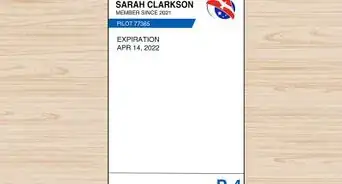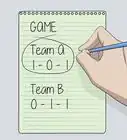This article was co-authored by wikiHow Staff. Our trained team of editors and researchers validate articles for accuracy and comprehensiveness. wikiHow's Content Management Team carefully monitors the work from our editorial staff to ensure that each article is backed by trusted research and meets our high quality standards.
There are 11 references cited in this article, which can be found at the bottom of the page.
This article has been viewed 86,093 times.
Learn more...
Skydiving is an exhilarating sport enjoyed by hundreds of thousands of people every year. Although the sport can be dangerous, the United States Parachute Association (USPA) has set guidelines that maintain safety within the sport, ensuring that every skydiver meet specific criteria. In order to become a licensed skydiver, join an Integrated Student Program near you to begin taking steps toward skydiving on your own.
Steps
Preparing for Your USPA License
-
1Meet the USPA medical requirements. All skydivers must carry a Third-Class Medical Certificate, granted by a doctor, in order to participate in a jump.[1] Visit your doctor and ask if you have any medical conditions that will prohibit you from skydiving. Ask if you are on any medications that will impair your ability to skydive, and talk about your medical history with your doctor. Request a Third-Class Medical Certificate and bring it with you on all future skydiving jumps.
- Avoid alcohol or other impairing drugs. Any person that has drunk alcohol or is on any drugs or medications that impair judgment and cognitive abilities is not allowed to skydive.[2]
-
2Meet the USPA age requirements of being 18 years or older. If you are under the age of 18, it is illegal for you to participate in any skydive activity in the United States.[3] If you are over 16 years old, you may be able to participate in some training in the United States, depending on the school, if you are granted parental consent. Before booking an appointment at a drop zone, ask what their age requirements are.
- If you are skydiving outside of the United States, ask your specific drop zone what their age requirements are before spending any money. Some countries will allow people of 16 years and older to skydive.[4]
Advertisement -
3Find a drop zone near you. Visit http://www.dropzone.com/dropzone/ to find the nearest drop zone and assess whether it is right for you. Consider the location and read reviews of the drop zone online. Be sure that the drop zone is affiliated with the USPA, which all U.S. drop zones should be, and ask if they offer first jump courses. Make your appointment with the drop zone of your choice.[5]
- Each drop zone will offer different services at different costs. Ask what elevation you will be diving from and whether the drop zone offers video footage to document your trip.
- Consider joining a skydiving club offered through a university or other organization. This will ensure you visit a reputable drop zone and you may make some friends along the way.[6]
-
4Be aware of the risks. As skydiving is an “extreme” sport, there are some very legitimate risks that must be taken into consideration before you pursue a skydiver’s license. The United States Parachute Association (USPA) has recorded an average of 35 skydiving fatalities every year, with hundreds of thousands of jumps recorded every year. [7] Take this risk into consideration before making your first jump and committing yourself to the skydiving school.
- Skydiving fatalities are rarely a result of equipment failure, as skydiving equipment has become more and more reliable over the years.[8] Fatalities are often a result of human error, so becoming a safe skydiving demands a high level of commitment and dedication.
Earning a USPA Skydiving A License
-
1Begin training in the Integrated Student Program (ISP). ISP training is an effective means of preparing a student for the USPA A license. Unlike other training schools, this training was developed to prepare students for all three methods of skydive training through a series of 25 jumps. The costs of these classes will vary, so compare prices in your area before making a decision.
- The ISP was developed by the USPA and is a comprehensive training outline that meets the USPA Basic Safety Requirements. Participating in an ISP course will properly prepare you for your USPA A license.
- USPA maintains a list of current Group Member drop zones on the USPA website, www.uspa.org.
-
2Achieve the required 25 jumps necessary to receive the A license. In order to receive your A license, a minimum of 25 solo jumps must be achieved. These jumps should be done through your ISP Program under supervision of an USPA licensed trainer.[9]
- Receiving an A license proves that a new skydiver has completed their training and is now cleared to jump without supervision.[10]
-
3Pass the USPA written and oral exams. Before receiving your USPA A license, you must pass a 40 question written USPA-developed A license exam and an oral quiz of at least 20 questions. The oral quiz is taken from the USPA ISP syllabus.[11]
- You must answer all of the oral exam questions correctly and pass the written exam with a score of at least 75 percent.[12]
-
4Undergo a supervised check dive with a USPA instructor. The check dive will be accompanied by an instructor who will look for you to show practical knowledge of the skydiving basics. Some of the criteria in this check dive include proper knowledge of the pre-jump equipment checks, break-off altitude recognition and tracking for a minimum of 100 feet (30.5 m), and properly packing and preparing equipment for the next jump. [13]
- For a comprehensive list of the check dive criteria, visit http://sim.uspa.org/#1=1%7C2=4%7C3=17%7Cpage=64.
-
5Have your A license signed by a USPA instructor. After all the above criteria are met, the instructor will sign your A license and it will be valid for 60 days. The instructor must apply the official USPA A license stamp as proof of license qualification.[14]
- After you have met the criteria and received approval from your instructor, submit the card to USPA Headquarters for processing in order for it to be considered a valid license beyond the 60-day time period.[15]
Moving Past the A License
-
1Pursue the USPA B, C, and D licenses. For a B license, you must properly record and approve 50 jumps and 30 minutes of freefall time. Record and approve 200 jumps and 60 minutes of free fall time for a C license, and 500 jumps with 3 hours of free fall time for the D license. With each new license, you will also be expected to perform new skills, including water landing training and being able to land within 7 feet (2.1 m) of a target.[16]
- Receiving a B, C, and D license will increase your knowledge of skydiving and function as a means of increasing safety and ability. [17]
-
2Purchase your own equipment. After receiving your A license, you will be cleared to legally skydive without supervision and will need your own skydiving equipment. Decide whether you would like to invest in new gear, or purchase used equipment until your are accustomed to skydiving on your own and know what kind of equipment best fits your needs.[18]
- The necessary gear includes an Automatic Activation Device (AAD), a main parachute, a reserve parachute, and a harness/container.
- For more information on whether to buy used or new gear, visit http://www.dropzone.com/safety/Gear_and_Equipment/A_Guide_to_Buying_Your_First_Skydiving_Gear_873.html.
-
3Become a part of a skydiving community. Through your A License training, try to join a community of skydivers to enjoy the sport with. This will allow you to stay motivated and accountable, as well as making skydiving more enjoyable. A fun group of fellow skydivers will allow you to travel more, as you will be able to split some funding, as well as discovering new places to jump.[19]
- Visit skydiving forums online for another way of connecting with the skydiving community. Visit reddit.com/r/skydiving or dropzone.com to find online forums.
-
4Practice in indoor wind tunnels. Although this method of practice is expensive, wind tunnels are a great way for you to practice maneuvering your body and enhance your skydiving skill. Many indoor skydiving establishments will keep logbooks to track your progress and put the experiences toward your licenses. [20]
- Find a wind tunnel facility near you by visiting forums like dropzone.com or by using basic search engines like google.com.
Community Q&A
-
QuestionHow to become a good skydiver and what ages you have to be to go skydiving
 Community AnswerIn the United States, you must be 18 years old or older in order to skydive. Once you are of age, joining an Integrated Student Program will teach you all the things you need to know to become a licensed, talented skydiver!
Community AnswerIn the United States, you must be 18 years old or older in order to skydive. Once you are of age, joining an Integrated Student Program will teach you all the things you need to know to become a licensed, talented skydiver! -
QuestionIs there a way to do this without a parachute and/or in nothing but a shirt and pants?
 Community AnswerNot without killing or at best severely injuring yourself. You need a parachute, otherwise you will fall far too fast.
Community AnswerNot without killing or at best severely injuring yourself. You need a parachute, otherwise you will fall far too fast. -
QuestionHow can I get a job in this profession?
 Community AnswerIn order to become a skydiving instructor, you need to become a member of the United States Parachute Association and have a D license, which requires at least 500 jumps and 3 hours of free fall time.
Community AnswerIn order to become a skydiving instructor, you need to become a member of the United States Parachute Association and have a D license, which requires at least 500 jumps and 3 hours of free fall time.
References
- ↑ http://sim.uspa.org/#1=1%7C2=3%7C3=14%7Cpage=44
- ↑ http://sim.uspa.org/#1=1%7C2=3%7C3=14%7Cpage=720
- ↑ http://sim.uspa.org/#1=1%7C2=3%7C3=14%7Cpage=45
- ↑ http://sim.uspa.org/#1=1%7C2=3%7C3=14%7Cpage=45
- ↑ http://www.dropzone.com/safety/Learn_to_Skydive/Find_a_reputable_Drop_Zone_515.html
- ↑ http://www.dropzone.com/safety/Learn_to_Skydive/Find_a_reputable_Drop_Zone_515.html
- ↑ http://www.dropzone.com/safety/Learn_to_Skydive/Be_Aware_Of_The_Risk_And_Requirements_513.html
- ↑ http://www.dropzone.com/safety/Learn_to_Skydive/Be_Aware_Of_The_Risk_And_Requirements_513.html
- ↑ http://skydiveparacletexp.com/2017/02/15/skydiving-license-levels-explained/
- ↑ http://skydiveparacletexp.com/2017/02/15/skydiving-license-levels-explained/
- ↑ http://sim.uspa.org/#1=1%7C2=4%7C3=17%7Cpage=64
- ↑ http://sim.uspa.org/#1=1%7C2=4%7C3=17%7Cpage=64
- ↑ http://sim.uspa.org/#1=1%7C2=4%7C3=16%7Cpage=60
- ↑ http://sim.uspa.org/#1=1%7C2=4%7C3=17%7Cpage=64
- ↑ http://sim.uspa.org/#1=1%7C2=4%7C3=17%7Cpage=64
- ↑ http://skydiveparacletexp.com/2017/02/15/skydiving-license-levels-explained/
- ↑ http://skydiveparacletexp.com/2017/02/15/skydiving-license-levels-explained/
- ↑ http://www.dropzone.com/safety/Gear_and_Equipment/A_Guide_to_Buying_Your_First_Skydiving_Gear_873.html
- ↑ http://www.jumptown.com/about/articles/how-to-become-a-great-skydiver/
- ↑ http://www.uspa.org/Portals/0/files/Form_ALicenseProfandApp.pdf
